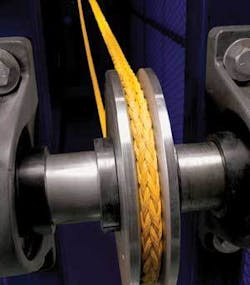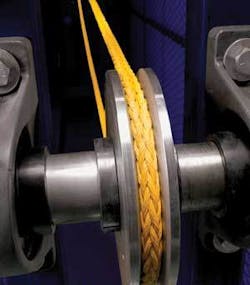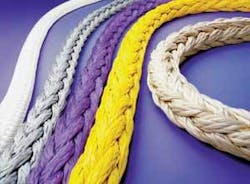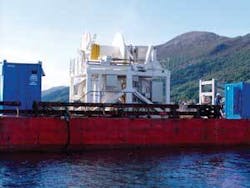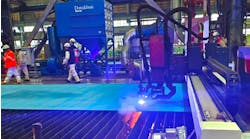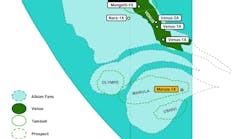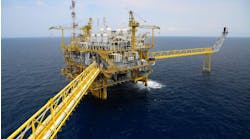Barbara McGrath Costain - Honeywell Specialty Materials
Sam Bull - Cortland Companies
As oil fields continue to be discovered in deeper waters, it has become increasingly important to find an effective method for deploying subsea hardware at greater water depths.
Conventional wire rope winch systems are quickly reaching their depth limitations, and the weight of large steel ropes are pushing the limits of conventional monohull offshore construction vessels. A very large winch system must be in place to hoist the steel, and smaller vessels may not be equipped to support the weight of the steel wire, let alone the winch required. Another matter that must be considered is the power required to hoist the entire length of the steel wire.
The weight of the steel doubles the winch power consumption at depths of greater than approximately 2,000 m. The depth limitations of these heavy steel ropes has opened the door for technological advancements in fiber rope lifting systems, bridging an important gap in offshore oil field developments in 2,000 m of water and beyond.
Deepwater alternative
Due to the substantial increases in weight, diameter, power-consumption, and eventually size of the handling gear, the industry has looked to alternatives such as synthetic fiber ropes and cables. Fiber ropes made with High Modulus Polyethylene (HMPE), such as Spectra fiber, have few limitations with respect to water depth, and minimal impact on size and weight. Spectra fiber, developed by Honeywell, is 10 times stronger than steel of equal weight, light-weight, naturally buoyant and resistant to wear-and-tear and degradation from water and most chemicals, as well as from ultraviolet radiation. Its earliest uses were in advanced technology for high-stress applications from ballistic armor for police to a wide variety of ropes and cordage.
As a result, there have been a number of initiatives to investigate the use of fiber ropes as a replacement for steel in deepwater operations. Two innovative winch designs, combined with rope technology have opened up this area. Honeywell’s Specialty Materials division, in partnership with The Cortland Cos. and partners, has been focused on this problem for the last few years. During this period substantial testing of materials and systems has resulted in the development of a new type of rope called braid optimized for bending (BOB) and innovative fiber rope deployment systems such as the Odim CTCU and Deep Tek patented winder system.
One challenge in deepwater has been to develop a suitable rope construction and material combination that will overcome specific problems associated with deploying large bodies. These include the effect of constant bend over sheave when using active heave compensation to ensure the payload is stable prior to subsea docking, removing the need for large splices when joining discreet lengths of rope, and producing torque-free robust ropes.
BOB is made up of a blend of Spectra fiber and Kuraray’s Vectran fiber. The combination of fibers and coatings has been specifically designed to endure repeated flexing around rotating sheaves.
Its patented 12 x 12 braid offers many advantages over conventional rope constructions including the ability to blend another fiber into select sections of the rope. For example, blending BOB with the Plasma 12 x 12 braided rope enables changing of the rope’s properties anywhere along its length to match various environmental conditions. In addition, the rope can be made any length without the need for large splices. It also has infield repairability, zero torque, and high strength translation efficiency.
The winch
Although there is now a suitable fiber rope designed specifically with deepwater lifting in mind, the next challenge is how to best handle the rope. Conventional winch systems have been designed specifically for use with steel wire. There are two major differences in the properties of fiber rope compared to steel wire that need to be considered when developing a rope handling system. They include very low coefficient of friction and rope elongation with load. Careful consideration needs to be given to these differences or the fiber rope will suffer from slipping on the winch sheaves, which will result in severe wear and premature failure.
Winches can be categorized essentially into three groups: drum, capstan, and two drum traction winches. Each winch type has specific limitations when used with fiber ropes. For example, drum winches store the ropes at their working load, which can result in premature damage to the rope. Also, if care is not taken, very high flange pressures can occur resulting in catastrophic failure of the drum winch.
Capstan winches rely on de-tensioning the rope over multiple wraps around the capstan. The change in rope length during the de-tensioning process results in slippage on the drum surface, which causes heat and build up within the rope. Traction winches suffer from the same problems. Although, the careful use of controlled back tensions can minimize this problem.
Deployment unit
The recently built ODIM CTCU (Cable Traction Control Unit) winch has been designed specifically to address the properties of fiber rope. It delivers some unique features, which prevent the rope from slipping against the traction sheaves caused by the elongation of the fiber rope under load. The CTCU also includes active heave compensation.
Odim’s winch system includes pulling capacity to meet variable payloads. It also has a combined back tension and storage winch for large volume storage capacity, an inboard damping device for accurate storage tension, spooling device, and outboard damping system used for accurate constant tensions.
Odim’s CTCU technology can be used for deepwater subsea hardware installation, mooring winch systems, abandonment and recovery winch systems, anchor handling systems, and deepwater coring winch systems. Vessel motions can cause high dynamic tension variations, especially when the period of vessel motions corresponds to the resonance period of the lifted system. The winch needs to compensate for vessel motions during launching, especially through resonant zones, and when landing on the seabed.
Below is a summarized comparison (estimates), using a 2,500-m (approximately 1.5 mi) water depth and a module payload weight of 218 metric tons (436,000 lbs) in water.
Field testing
First, this technology was field tested from a barge in depths of 100 m, including a single fall test using 56-mm BOB, and a multi-fall test using 18-mm BOB. A subsequent trial was performed in the Ormen Lange field and proved successful.
The objective of the field pilot was to demonstrate that the CTCU winch system can perform subsea lifting operations using 56-mm BOB rope instead of steel wire. Geoconsult AS’s Geofjord, a high-utility ROV/construction support vessel carried out the installation operation.
The field pilot involved installing three 35-metric ton gravity anchors in 850 m of water. Each anchor was lowered to the seabed and installed with the aid of a work class ROV. Anchor positions were logged with a subsea motion detector to study the CTCU system’s ability to control the payload position and rope tension at resonant conditions.
| Diameter (mm) | Weight (Te) | Power Consumption (MW) | Winch (Te) | System Weight (Te) | |
|---|---|---|---|---|---|
| Fiber rope | 114 | 22 | 1.3 | 218 | 130 |
| Steel wire | 141 | 215 | 2.4 | 396 | 400 |
| Note: Te = metric tons, MW = megawatts, mm = millimeters. | |||||
Plasma meets winch
In the summer of 2004, a UK-based deepwater salvor, Deep Tek Ltd., needed a method to salvage materials aboard thePersia, a WWI era mail ship that was resting approximately 3,000 m under the surface of the Mediterranean Sea. They recognized that this record setting deepwater maneuver would require innovative technology and realized that the weight penalty and corrosive nature of conventional steel wire rope would limit the job’s lifting capacity and reduce the working life of the rope.
They realized that harnessing high-performance fiber rope was the only way of opening up the seabed for continued and sustainable exploitation. Accordingly, they designed and developed a patented winder, which replaces a conventional hoist umbilical, by helically wrapping power and signals around a synthetic fiber strength member, as the underwater equipment is lowered, and winds them off again when it is being recovered. A custom braided Plasma 12 x 12 strand rope from the Cortland Companies’ Puget Sound Rope was used during this operation.
This technology is being marketed by Deep Tek Ltd. as a cost-effective means of undertaking work in any water depth, whether the application is in salvage, military, the oil and gas industry, or science. They are currently developing the Winder System to lift 75 metric tons in up to 3,500 m of water specifically for the oil and gas industry.
Viable solution
Fiber Rope Systems provide an enabling technology, giving operators a viable option for deepwater deployment. In addition, these technologies can be used on a wide range of smaller vessels, resulting in lower day rates, greater vessel availability, and significant cost savings. More specifically, the reduced weight of the winch and rope systems allow for much faster deployment and recovery speeds. When working in water depths of 3,000 m, this can translate into huge time savings.
